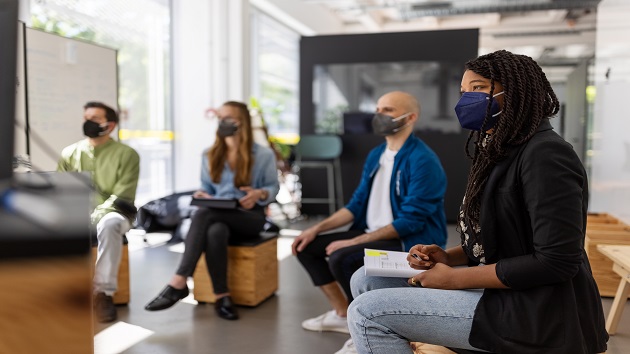Five ways we’ll know COVID has become endemic: ANALYSIS
Luis Alvarez/Getty Images/Stock Photo
(NEW YORK) — Recently, an update to the national COVID-19 strategy was released, designed to manage the virus so most Americans can return to daily life without disruption.
The country is moving to a new phase in which the COVID-19 threat changes from “pandemic” to “endemic.” That means the virus will likely continue to circulate within the population, but at low rates or seasonally.
The updated strategy should fill us with optimism. But we should couple that with a healthy dose of caution.
“As we move toward a COVID-controlled life, it’ll be ever-important to assess for real-time changes in the virus and its community impact because we know just how unpredictable this virus can be,” said Dr. Atul Nakhasi, an internist at the Martin Luther King Jr. Outpatient Center in Los Angeles.
How can we know if it’s safe to unmask and resume our normal activities? What signals should we look for to determine if we need to resume social distancing? Below are five indicators that may provide us with answers.
1. Case numbers:
In Los Angeles County, where Nakhasi practices, public health officials have developed an alert system designed to signal the risk level of the virus. If the number of new cases stays below 200 per 100,000 people, then the risk level remains low.
Though vaccination plays a key role in keeping case numbers low, it’s not the only way to get there. Most people who become infected with COVID-19 develop some level of immunity to the virus. Widespread infections combined with vaccinations have led one group of scientists to determine that 73% of Americans are, at least for now, immune to omicron, the dominant variant. They say that percentage could increase to 80% by mid-March.
2. Hospitalizations:
If we see hospitalizations continue to decrease and remain stable, that will suggest endemicity. The CDC has pivoted away from case numbers to focus on hospitalizations. That’s because, even if the overall reported number of cases stay low, an increase in hospitalizations could indicate that the virus has mutated and the risk of infection may be increasing rapidly.
“A new phase of the pandemic requires a recalibration of metrics that directly highlight true population impact,” said ABC News contributor and Chief Innovation Officer at Boston Childrens Hospital John Brownstein, P.h.D.
“While cases have uncoupled from severe illness, hospitalization numbers will continue to be a robust indicator that public health can rely on,” he added. “Though not the most timely (measure), hospital capacity will continue to reflect risk levels in communities and help guide decisions on mitigation efforts.”
3. Death rates:
According to Jodie Guest, an epidemiologist at Emory University, one measure of the severity of the virus is death rates. If we see fewer than 100 COVID-19 deaths a day nationwide, according to Guest, the virus has reached the endemic phase. Of course, we will need to keep an eye on variants and particular regions of the country where community spread may be different.
4. Wastewater samples:
Yeah, it’s gross, but the wastewater that flows through our sewer systems can tell us a lot about diseases that might be circulating in the community. In fact, data from the CDC’s National Wastewater Surveillance System showed that 70% of wastewater facilities found that virus levels had decreased compared to two weeks ago — another sign COVID-19 cases are on the decline.
Wastewater samples are especially important because people shed the virus when they are in the early stages of infection. That means we can identify rising infection rates even before people begin to show symptoms.
Dr. Ted Smith, an associate professor of environmental medicine at the University of Louisville School of Medicine, said that “wastewater concentrations are dropping in North America.” Though he cautions that infection rates typically drop in the spring and summer, “the genomics is supportive of a tamped situation.”
5. Outbreak clusters:
If we’ve learned anything at all about COVID-19, it’s that it’s highly contagious. That means public health officials need to be able to identify clusters of outbreaks in schools and workplaces, which likely portend rising levels of disease.
One big caveat:
As we move into the endemic phase of the virus, many people will be tempted to think COVID is a thing of the past. If only it were so. For one thing, every community is different. Vermont’s vaccination rate is around 80%, while Alabama’s is closer to 50%. Residents of these two states are facing two very different scenarios in the months ahead.
Likewise, even in cities like Los Angeles, Nakhasi warned that “it’s really important for us to recognize the disproportionate impact this virus has had on our under-resourced and vulnerable communities and prioritize their health, well-being, and life as we prepare for the next surge.”
Also, just because fewer of us are getting sick, doesn’t mean we shouldn’t take smart precautions like washing our hands and continuing to get booster shots when recommended.
“We are in an endemic phase when cases, hospitalizations, and deaths have reached a steady state,” said Dr. Megan Ranney, a practicing physician and dean at Brown University’s School of Public Health. “Remember, though, that ‘endemic’ is not the same as ‘not dangerous.'”
Dr. Jay Bhatt is an internist, instructor at UIC School of Public Health and an ABC News contributor.
Copyright © 2022, ABC Audio. All rights reserved.

